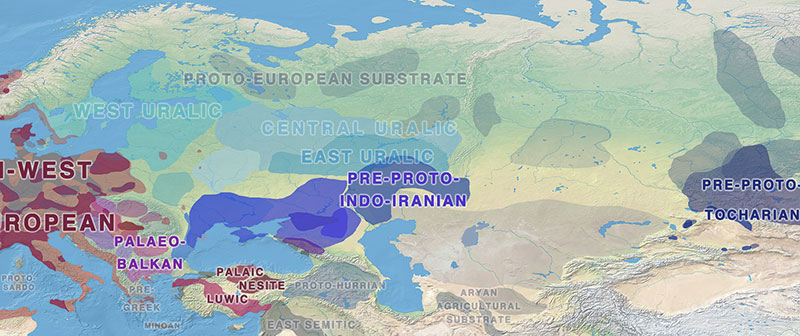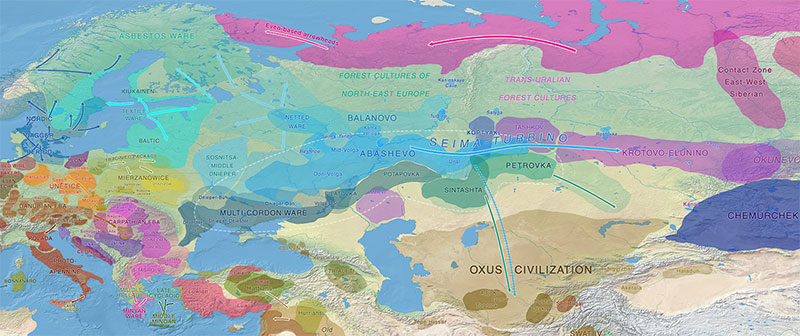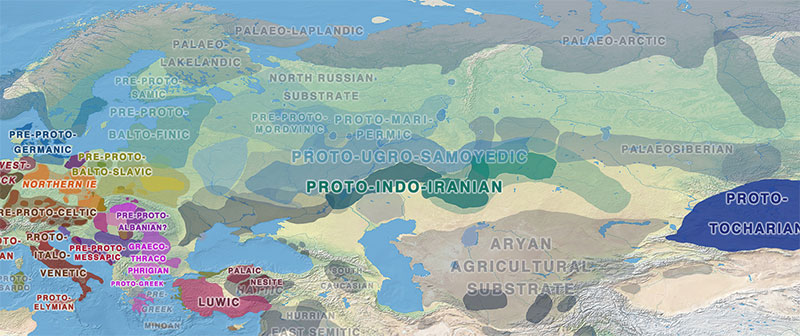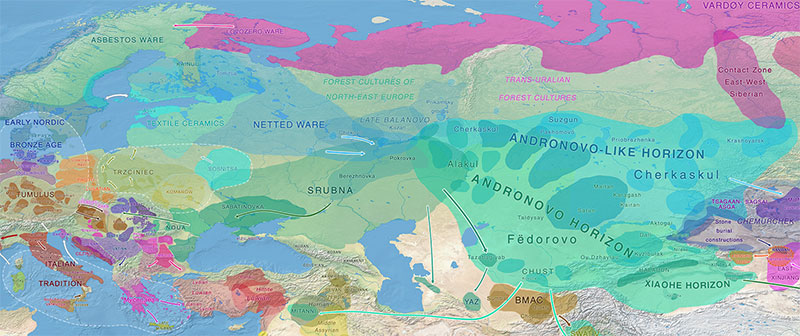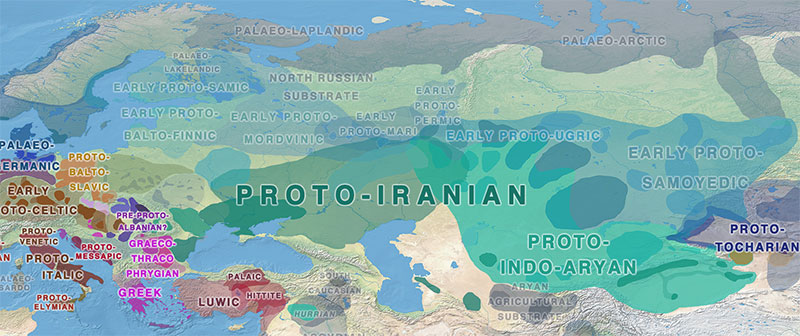Open access PhD thesis Indo-Iranian borrowings in Uralic: Critical overview of sound substitutions and distribution criterion, by Sampsa Holopainen, University of Helsinki (2019), under the supervision of Forsberg, Saarikivi, and Kallio.
Interesting excerpts (emphasis mine):
The gap between Russian and Western scholarship
Many scholars in the Soviet Union and later the Russian Federation also have researched this topic over the last five decades. Notably the eminent Eugene Helimski dealt with this topic in several articles: his 1992 article (republished in Helimski 2000) on the emergence of Uralic consonantal stems used Indo-Iranian and other Indo-European loans as key evidence, and it was one of the first serious attempts to stratify the loanwords, paying attention to the non-initial syllables as well. Helimski (1997b) discusses Indo-Iranian loanwords more generally, but it is especially notable for the introduction of the “Andronovo Aryan” idea: Helimski argues that some loanwords in Ob-Ugric and Permic are derived from an unattested, third branch of Indo-Iranian. Helimski’s idea has been supported by at least Mikhail Zhivlov in a 2013 article, but otherwise it has not received wide acceptance. Helimski was also known for his criticism (see especially Helimski 2001) of Jorma Koivulehto’s etymological work: although the main targets of Helimski’s criticism were Koivulehto’s writings on Proto-Indo-European and Germanic borrowings (which fitted poorly with Helimski’s ideas of the Nostratic roots of Proto-Uralic and his other theories on Uralic linguistic prehistory), also some of his Indo-Iranian ideas received unnecessarily sharp criticism in Helimski (2001).
Vladimir Napol’skikh is another important Russian scholar who has written on several occasions about Indo-Iranian–Uralic contacts. His 2014 article is notable for its criticism on Helimski’s Andronovo Aryan theory and his arguments in favour of Indo-Aryan loanwords. Napol’skikh also considered some of the traditional Indo-Iranian loanwords to be borrowings from Tocharian (see below) in some of his earlier works, an idea which has been criticized by Kallio (2004) and Widmer (2002) and which Napol’skikh himself has since dropped in later publications (2010, 2014), where many of these alleged Tocharian loans are again considered Indo-Iranian.
Some of the main characteristics of Russian research is that the earliest Indo-European loanwords are usually considered to represent an inheritance from the Nostratic proto-language (Helimski [2001]; Kassian, Zhivlov & Starostin [2015]), an idea which is not widely accepted by scholars of Uralic in the West. Although this often does not concern the Indo-Iranian loanwords at all, or it concerns only a part of them, the works of Jorma Koivulehto, who dealt with both earlier Indo-European and Indo-Iranian loans, receive so much criticism from the Russian scholars that his important ideas are often totally rejected or left unmentioned in Russian research.
This kind of rejection of central etymological research literature can be considered one of the most pressing problems in Uralic loanword studies, and it leaves a regrettable gap between Russian and Western European scholars in this perspective.
Semantics
Among the Indo-Iranian loanwords in Uralic, one can easily mention examples that follow the classification of semantic change as described above. For widening or generalization, vasara ‘hammer’ is a good example: the Indo-Iranian original denotes ‘the weapon of the god Indra’ in Indic and ‘the weapon of the god Mithra’ in Avestan, whereas Finnish ‘hammer’ (and the Mordvin meaning ‘axe’) are more general meanings of tools. Fi huhta is a good example of narrowing: Iranian *tsuxta- means simply ‘burned’, whereas in Finnic huhta means specifically ‘a burned patch used in slash-and-burn agriculture’. Metonomy has taken place in Mordvin, where čuvto denotes simply ‘tree’; this probably developed through the meaning ‘wood burned for agriculture’. Khanty (South) wǟrəs denotes ‘horse’s mane’, but its Iranian original probably had a more general meaning of hair (cf. Avestan varəsa- ‘hair of human and animal, mostly hair of the head’).
An interesting example of degeneration is the etymology of Finnic orja ‘slave’, probably borrowed from the Indo-Iranian ethnonym *(H)ārya- ‘Aryan’ (for the original semantics of this word, see the entry *orja in Chapter 2). A similar development is seen in English slave which is etymologically connected to the ethnonym Slav.
Distribution as a criterion in the dating of loanwords
(…) some of the Indo-Iranian loans seem to have a wide distribution, but upon a closer look it becomes clear that they include phonological irregularities, which can only be explained by assuming that they are parallel loans. The ability to recognize parallel borrowings is extremely important in Uralic loanword studies, and it has been developed with success in the research of Germanic and Baltic loanwords (see Junttila 2015).
Interestingly, K. Häkkinen (1983: 207) argues that although words disappear from languages, the most basic words often remain stable and are maintained for longer periods. Although this is probably true, here the notion of “basicness” is something that is open to different interpretations. Many central concepts in culture and livelihoods are often described with prestige words that are borrowed, and these central words can be very easily replaced. In determining the age of the loanwords one has to always keep in mind that a reflex of a very early cultural borrowing from Indo-Iranian to Proto-Uralic/Proto- West Uralic etc. can easily have been lost in some daughter language, if a later prestige loan for the same concept has been borrowed from some later contact language (such as from some form of Germanic or Baltic into Finnic or from some Turkic language into Udmurt, Mari or Mordvin).
In Uralic linguistics the common loanword layers shared by some intermediary proto-language have often been seen as giving support to the reconstruction of these stages, but K. Häkkinen (100–108) considers this problematic. It should also be noted that the distribution of Indo-Iranian loanwords very rarely matches the assumed taxonomic divisions: there are some loanwords confined to the Finno-Permic, Finno-Volgaic or Ugric languages, but very few loanwords that would be Finno-Permic, Finno-Volgaic or Ugric in the way that the word is found in all the languages that belong to the branch.
Consontants
Laryngeals
There are only very few possible examples of a consonantal substitution of the word-initial laryngeal. It seems probable that the word-initial laryngeal, if it was retained, was not substituted in any way in Uralic. *karšV (> Fi karhu), an uncertain etymology, is the only possible example.
(…) Even if *k was a result of laryngeal hardening, the development would probably be earlier than Proto-Indo-Iranian, meaning that by the time the word was borrowed, the Indo-Iranian word simply had the stop *k that was regularly substituted by Uralic *k.
Evidence for Andronovo Aryan and Indo-Aryan loanwords?
None of the loanwords have to be considered as Andronovo Aryan or Proto-Indo-Aryan based on the criteria that were presented in the Introduction. The Uralic palatal affricate *ć or sibilant *ś can in all cases be explained from Proto-Indo-Iranian *ć, and there is no need to assume that it should reflect Andronovo Aryan *ć or PIA *ś. In the etymological material of this study, no further positive evidence was found for the distinction of PU *ś and *ć as substitutions of the Proto-Indo-Iranian affricates. This means that at least in word-initial position there probably was no difference between *ć and *ś, and even though we do not know what this sound was phonetically, it is safe to assume that Uralic words showing *ś reflect a sound substitution of Indo-Iranian *ć and *Ʒ́.
Regarding the distribution of the etymologies within Indo-Iranian, all the loanwords which cannot be from Iranian because of the lack of attested Iranian cognates have a more or less secure Proto-Indo-Iranian etymology, and nothing prevents us from assuming that these words reflect Proto-Indo-Iranian borrowings. It is also possible that some words with solid Proto-Indo-Iranian etymologies were present in Iranian but were lost before the first Old Iranian texts were composed.
List of Indo-European and Indo-Iranian Etymologies
Pre-Indo-Iranian
*ertä ‘side’, *kekrä ‘wheel’, *kečrä ‘spindle’, *mekši ‘bee’, (*meti ‘honey’), *ońća ‘part’, (*orpa ‘orphan’), *peijas ‘feast’, *pejmä ‘milk’, Pre-P *pertä ‘wing’, *repä ‘fox’, *rećmä ‘rope’, *sejti ‘bridge’
Proto-Indo-Iranian
*aćtara ‘whip’, *anti/onta, *ora ‘awl’, *orja ‘slave; south’, (*orpa ‘orphan’), *pośi ‘penis’, *śaŋka ‘handle’, Pre-Md *śaγa ‘goat’, *śarwi ‘horn’, *śaδa- ‘to rain’, śara- ‘shit’, *śi̮ta ‘hundred’, Pre-P *śVta ‘hundred’, *śasra ‘thousand’, *śišta ‘wax’, *śoma- ‘sad’, *waćara ‘hammer’, *woraći ‘boar’
Ambiguous early loans (can be either from PII or PI)
*ajša ‘shaft’, *asVra ‘lord’, *iha ‘yearning. passion’, *ihta ‘lust’, *jama ‘twin’, *jawi/jowa (> Mo juv) ‘awn’, *jawi (> PS *jäə̑) ‘flour’, *ji̮ni ‘way, path’, *juma ‘god’, *kana- ‘to dig’, *kara- ‘to dig’, *kata- ‘to graze’, *kertä- ‘to bind’, *ki̮ntaw ‘tree stump’, *kürtńV ‘iron’, PKh *kǟrtV ‘iron’, *kärtä ‘iron’, *martas ‘dead’, *ńātV- ‘to help’, *pakas ‘god’, *para ‘good’, Kh pĕnt ‘way’, PMs *pē̮ńtV ‘brother-in-law’, *pora ‘old’, *poči- ‘to boil’, Pre-P *porta ‘vessel’, *puntaksi ‘bottom’, Pre-Ma *pänti- ‘to bind’, PMa *pärća ‘ear of corn’, *pätäri- ‘to flee’, *saγi- ‘to get, obtain’, *sampas ‘pillar’, *saŋka ‘old’, *sara ‘lake’, *sasara ‘sister’, *säptä ‘seven’, *tajwas ‘sky’, *takra ‘piece of flesh’, *tarna ‘grass’, *tojwV ‘wish’, *toraksi ‘through’, *tora- ‘to fight’, *täjV ‘milk’, *täjinV ‘cow’, *täši, *uška ‘bull’, *wakša- (> PS *wåtå-) ‘to grow’, *wajna- ‘to see’, *wojna- ‘to see’, *wiša ‘venom’, *wi̮rna ‘wool’, *wärkä ‘kidney’, PS *wǝ̑rkǝ̑ ‘wolf’, *wirtV- ‘to hold, raise’, *äŋkärä ‘coal’
List of uncertain Indo-Iranian etymologies
PFi *aiwa (← Germanic ?), Ma *arša ‘mane’, PMs *ǟrV ‘fire’, *aštira ‘barren earth’, POug *ćakV ‘hammer’, *ćara- ‘brown; ? to dawn’, *ćero ‘hill-top’, *ćerti ‘group’, *itä- ‘to appear’, Pre-Fi *karšV ‘bear’, PMs *kīrV ‘iron’, *kota ‘chum’, Pre-Sa *kupa ‘pit’, PFi *kärsä ‘snout’, *maksa- ‘to pay’, PFi *mana-, PUg ? *mańći, Ma marij ‘Mari; man; husband’, *mē̮ja ‘wedding’, *mykkä ‘dumb’, PP *oč ‘corn’, *orpV ‘relative’, PFi *paksu ‘thick’, *peji- ‘to milk’, *pi̮ŋka ‘psychedelic mushroom’ POUg *porV ‘phratry’, Pre-Sa *poti ‘against’, Pre-Fi *šatas ‘germ’, *sentü- ‘to be born’, *šerä- ‘to wake up’, Ms šVšwǝŋ ‘hare’, PUg *śeŋkV ‘nail’, Pre-Sa *soma/sami ‘some’, PP *sur ‘beer’, PFi *süte- ‘to hit’ (< ? *sewči-), Hu szekér ‘wagon’, Kh ʌīkər ‘Narte’ PUg *taja- ‘secret’, Pre-Fi *terni ‘young’, *terwV ‘healthy’, ? *towkV ‘spring’, PWU *utarV ‘udder’ (← Germanic ?; Mari *waδar ← II), *waŋka ‘hook’, Mo E v́eŕges, M vərǵas ‘wolf’
Etymologies that were probably borrowed from another Indo-European source (PIE, PBSl, Germanic, Baltic)
*aisa ‘shaft’ ← Balto-Slavic, PFi *aiwa (← Germanic ?), *apV ‘help’ ← Germanic, *jewä ‘grain’ ← Balto-Slavic, Ma karaš etc. ‘honeycomb’ ← Baltic, (*meti ‘honey’ ← ? PIE,) Fi *ojas ‘shaft’ ← Slavic, *ola ← Baltic, *oŋki ← Germanic, *porćas ← Balto-Slavic, Pre-Sa *porta ‘vessel’ ← Germanic, *salV ‘salt’ (cannot be reconstructed for PU, various later parallel loans), *śi̮lkaw ← Balto-Slavic, *sammu- ← Germanic, *śuka ← Balto-Slavic, Mari *šŭžar ← Baltic/Balto-Slavic or Slavic, *tejniš ‘pregnant animal’ ← Baltic/Balto-Slavic, PWU *utarV ‘udder’ (? ← Germanic)
Early loans into differentiated branches
Proto-West Uralic
Only in Finnic:
*aćnas ‘voracious’, *iha ‘wish’, *ihta ‘lust’, PFi *isV ‘appetite’, *martas ‘dead’, *očra ‘barley’, *peijas ‘feast’, *pejmä ‘milk’, *pe̮rna ‘spleen’, *sampas ‘pillar’, *sooja ‘shelter’, *tajwas ‘sky’, *takra ‘piece of flesh’, *terwV ‘healthy’, *tojwV ‘wish’
All of these words, with the exception of *sooja ‘shelter’, were clearly borrowed into Early Proto-Finnic (Pre-Finnic) at the latest. Formally most of the loans could be from PII or PI.
Only in Saami:
*kata- ‘to graze’, *kertä- ‘to bind’, *pora ‘old’, *wojna- ‘to see’
All of the loans were acquired before the Saami vowel changes. Formally all could be either from Proto-Indo-Iranian or Proto-Iranian.
Only in Finnic and Saami:
*asma ‘voracious’, *jama ‘twin’, *kekrä ‘wheel’, *mača ‘insect’
*asma ‘voracious’, *jama ‘twin’, *kekrä ‘wheel’, *mača ‘insect’ Of these, *mača from Proto-Iranian and *jama is ambiguous. As the -sm- in asma does not point to Proto-Indo-Iranian *ć, this is probably an Iranian loan too. It is possible that these words were borrowed into Proto-West Uralic, as there is no general support for a Finno-Saamic proto-language today. As the cognates within Finnic and Saami are regular, there is no need to assume parallel borrowings. *kekrä has to be from Proto-Indo-Iranian.
NOTE. Based on the discussion of stages of borrowing from Indo-Iranian, and of the distribution of *kekrä among Uralic dialects in particular, Holopainen probably means Pre-Indo-Iranian for this example.
Only in Mordvin and/or Finnic and/or Saami (can point to a borrowing into Proto-West Uralic):
*ji̮ni ‘way’, *kečrä ‘spindle’, *rećmä ‘rope’, *śaŋka, *waćara ‘hammer’, *warsa ‘foal’, *wasa ‘calf’, *woraći ‘pig’
Based on phonological criteria, these loans do not form a chronologically coherent layer, but probably their modern distribution is accidental (their original distribution can have been wider). *kečrä ‘spindle’ and *rećmä ‘rope’ are from Pre-II, *śaŋka, *waćara and *woraći from PII, *warsa and *wasa from later Iranian (Alanic). *ji̮ni is ambiguous. Also the loans confined to Finnic and Saami mentioned above probably were borrowed into Proto-West Uralic, as it is a more convincing taxonomic entity than Proto-Finno-Saamic.
Proto-Mari-Permic
Only in Mordvin, Finnic and/or Saami and Mari
*juma ‘good’
This loan can be either from PII or PI. As it is obvious that these four branches do not form any taxonomical entity (Salminen 2002; J. Häkkinen 2009), it is only logical that there are no other loanwords with a “Finno-Volgaic” distribution.
Only in Mari:
*kVrtnV ‘metal’ (← PII, PI or later), Pre-Ma *pänti- ‘to bind’, PMa *pärća ‘ear of corn’, *si̮rńa ‘gold’ (← Old Iranian)
Only very few early Indo-Iranian loans can be found in Mari and in no other Uralic language. It is unclear what the reason for this is. It is, of course, possible that some uncertain loanwords like marij ‘man; Mari’ turn out to be correct after all, but even that does not make the number of loans in Mari very high. The situation has to be explained either with loss of vocabulary and replacement by later loans (from Turkic, and also perhaps from Permic) or with Mari’s location on the periphery at the time of the later contacts with the Iranian languages. Agyagási (2019: 254–258) argues that the current area where Mari is spoken was formed only relatively late, after the Mongol invasion in the High Middle Ages. If this is indeed correct, and Mari was spoken in more northern areas before that, it can be assumed that Pre-Mari had only sporadic contacts with the Iranian languages after it split off from Proto-Uralic.
Only in Permic (early loans; for later loans confined to Permic)
*a(č)wa ‘stallion’, PP *ju ‘awn’, *kertä ‘house’, *kärtä ‘metal’, *kada- ~ *gada- ‘to steal’, *karka ‘chicken’, *parśa ~ *barśa ‘mane’, *parta ‘knife’, *pertä ‘wing’, *poči- ‘to boil’, *porta ‘vessel’, *dura ‘long’, *domV ‘to tame’, PP *śumi̮s ‘band’, PP *šud‘luck’, *uška ‘bull’, *wi̮rna ‘wool’, *wirä ‘man, husband’, *äŋkärä ‘coal’
The number of loanwords in Permic is relatively high, and many of these can be considered to be Iranian loanwords. Technically many loans are ambiguous, but as some of the words were borrowed late due to historical reasons (‘iron’), and some were borrowed into a Pre-Permic which already had a phonological system that was different from Proto-Uralic (*šud- has d which cannot reflect PU *δ).
It is probable that the Permic languages were in continuous contact with the Indo-Iranian languages from the time they split from Proto-Uralic until the early mediaeval era.
Proto-Ugro-Samoyedic
Only in Khanty and Mansi (regular cases):
POUg *ēräɣ ‘song’, POUg *eträ ‘clear sky’, POug *mɔ̈ŋki ‘forest-spirit’, *ńātV- ‘to help’, *päčäɣ ‘reindeer’
The number of these etymologies is so low that it is very difficult to determine whether these words were borrowed into Proto-Ob-Ugric or some earlier proto-language, such as Proto-Ugric.
Only in Khanty and/or Mansi and/or Hungarian (regular cases):
*säptä ‘seven’ (Khanty + Hungarian regular), *sara ‘lake’
There are so few convincing loanwords with a “Ugric” distribution that they provide very little evidence. Either of these loans could be from Proto-Indo-Iranian or Proto-Iranian, if we assume that *s > *h was a common Iranian sound change. Both loans were acquired
Only in Samoyed:
*jäwi (> PS *jäə̑), PS *pulə̑ ~ *pi̮lə̑ ‘bridge’, *täjki ‘spear’, PS *wǝ̑rkə̑ ‘wolf’, Pre-S *täši (> PS *tät), *wakša- (> PS *wåtå) ‘to grow’
Of these, only *wåtå- has to be a very early loan because of *s > *t. *jäwi (> PS *jäə̑) and PS *wə̑rkə̑ were possibly acquired before the Proto-Samoyed vowel developments, making them probably early loanwords too. Formally all of them could be either from PII or PI. *pulə̑ ~ *pi̮lə̑ could have been borrowed into Proto-Samoyed (with Iranian *u corresponding to Samoyed *u), and because of the *l the word is probably from a relatively late, Middle Iranian language.
The following loanwords have a distribution with a cognate in both Samoyed and some other branch:
*śaδa- ‘to rain’, *tora- ‘to fight’ (also *itä-, which is more uncertain, belongs here)
Pan-Uralic loans
The following loanwords have a distribution with regular cognates with at least one Ugric branch and some other branch, which points to early borrowing. Although formally *kana- and *kara- are ambiguous, they are probably from Proto-Indo-Iranian because of their distribution. The rest of the loans are from Pre-II or PII.
*kana- ‘to dig’, *kara- ‘to dig’, *meti ‘honey’, *mekši ‘bee’, *orpV ‘orphan’, *ora ‘awl’, *peji- ‘to milk’, *pätäri- ‘to flee’, *śara- ‘shit’, *śoma- ‘sad’
The following loanwords are found in at least two non-adjacent branches of Uralic (the ones listed in the above categories are not counted). As there are no widely accepted criteria for a word to be considered “Uralic”, all of these could be considered loanwords into Proto-Uralic, in this case probably from Proto-Indo-Iranian or Pre-Indo-Iranian.
*ajša ‘shaft’, *anti/onta ‘grass’, *ertä ‘side’, *ki̮ntaw ‘tree stump’, *mertä ‘human’, *orja ‘slave’, *para ‘good’, *počaw ‘reindeer’, *puntaksi ‘bottom’, *saγi- ‘to get, obtain’, *repä ‘fox’, *si̮ŋka ‘old’, *sasara ‘sister’, *sejti ‘bridge’, *śišta ‘wax’, *tarna ‘grass’, *toraksi ‘through’, *wiša ‘venom’
Discussion about the distribution and its impact on Uralic taxonomy
(…) there are Proto-Iranian loanwords which were borrowed simultaneously into several early branches of Uralic, making it likely that Uralic had split into several branches by the time of these contacts.
Also the fact that many of the Proto-Indo-Iranian loanwords either show a restricted distribution (such as West Uralic *waćara, *woraći) or irregular correspondences (*asVra, *śasra, *śi̮ta) can point to the conclusion that Proto-Uralic was fragmenting by the time when contacts with Proto-Indo-Iranian took place.
The earlier, Pre-Indo-Iranian loanwords usually show a wider distribution and regular sound correspondences. Although the number of these earliest loans is quite small, based on their distribution and regular correspondences it can be assumed that the Pre-Indo-Iranian stage (after RUKI, *l > *r and the merger of velars and labiovelars but before the merger of non-high vowels) was concurrent with Proto-Uralic, with the changes leading to Proto-Indo-Iranian happening after the dispersal of Proto-Uralic.
The distribution of loanwords reinforces the old idea that Samoyed is a lexical outlier, as only few convincing Indo-Iranian etymologies for Proto-Uralic words (*saδa- ‘to rain’, *tora- ‘to fight’) have a convincing reflex in Samoyed. However, the fact that such etymologies exist means rather that the situation is due to lexical loss in Samoyed, and that the earliest contact occurred before Samoyed split off from Proto-Uralic.
There are very few loanwords that have a Ugric distribution (being found in at least one Ob-Ugric branch and Hungarian), and likewise rather few in Ob-Ugric. The few loans that have a distribution confined to Ugric were borrowed before the change *s > *θ took place. This means that the Ugric distribution does not mean much from the point of view of chronology or taxonomy, as the words were borrowed into a language that was still identical to Proto-Uralic. Even some loans borrowed into Khanty and Mansi have to be so early.
Impacts on dating and the location of the contact zones
Because of the very limited number of convincing etymologies found only in Finnic or Saami, it is probable that there were not (extensive) contacts with Pre-Finnic or Pre-Saami after the split of Proto-West Uralic.
The great number of loanwords of varying ages in Permic inevitably points to the conclusion that the pre-form of the Permic branch had been constantly spoken in an area that was adjacent to the Iranian languages. The different layers of loanwords in Permic clearly point to chronological differences in the donor languages, but it also seems that Permic was in contact with various forms of Iranian and not with different diachronic stages of the same language.
In general, the words that have been borrowed are typical cultural words, and the contacts between Indo-Iranian and Uralic seems to have been a typical contact situation in which a culturally less-advanced language group borrows various cultural terms from a more “advanced” group. The words in various loanword layers related to horse and cattle breeding show obvious cultural influence in the field of domesticated animals, and the borrowing of some names of grains points to agricultural influence from the Indo-Iranians on the speakers of Uralic.
Needless to say, many of the borrowings I listed in A Song of Sheep and Horses suffer from the same ailment attributed to Indo-Europeanists in general:
With slight exaggeration one can agree with the remark by Koivulehto (1999a: 209–210) that the Indo-Europeanists often use outdated sources or are simply uninterested in the topic. The problem is further complicated by the various and often obsolete views expressed in even relatively modern Uralicist works, such as those of Rédei (1986c; 1988) or Katz (2003); (…) Mallory & Adams (2006) adequately refer to the importance of the early loanwords, but they use mostly Rédei’s outdated reconstructions and stratigraphy in support of their theories.
I need to review all related texts with this thesis and the works recently published by Kümmel, as well as the recent book of the Leiden school on Indo-Uralic.
Also, does anyone know the (traditional?) why of the resistance to the Indo-Uralic concept among Uralicists? Maybe it’s a reaction against the Nostraticist and Siberian views of Uralic espoused by the Soviets?
Related
- Samoyedic shows Yeniseic substrate; both influenced Tocharian
- Corded Ware ancestry in North Eurasia and the Uralic expansion
- Haplogroup R1a and CWC ancestry predominate in Fennic, Ugric, and Samoyedic groups
- Uralic speakers formed clines of Corded Ware ancestry with WHG:ANE populations
- Corded Ware—Uralic (III): “Siberian ancestry” and Ugric-Samoyedic expansions
- Genetic continuity among Uralic-speaking cultures in north-eastern Europe
- Volosovo hunter-gatherers started to disappear earlier than previously believed
- European hydrotoponymy (IV): tug of war between Balto-Slavic and West Uralic
- The cradle of Russians, an obvious Finno-Volgaic genetic hotspot
- Aquitanians and Iberians of haplogroup R1b are exactly like Indo-Iranians and Balto-Slavs of haplogroup R1a
- Pre-Germanic and Pre-Balto-Finnic shared vocabulary from Pitted Ware seal hunters
- Pre-Germanic born out of a Proto-Finnic substrate in Scandinavia
- On Proto-Finnic language guesstimates, and its western homeland
- On the origin and spread of haplogroup R1a-Z645 from eastern Europe

